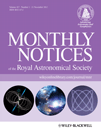Impact of redshift information on cosmological applications with next-generation radio surveys
ABSTRACT
In this paper, we explore how the forthcoming generation of large-scale radio continuum surveys, with the inclusion of some degree of redshift information, can constrain cosmological parameters. By cross-matching these radio surveys with shallow optical to near-infrared surveys, we can essentially separate the source distribution into a low- and a high-redshift sample, thus providing a constraint on the evolution of cosmological parameters such as those related to dark energy. We examine two radio surveys, the Evolutionary Map of the Universe (EMU) and the Westerbork Observations of the Deep APERTIF Northern sky (WODAN). A crucial advantage is their combined potential to provide a deep, full-sky survey. The surveys used for the cross-identifications are SkyMapper and Sloan Digital Sky Survey, for the southern and northern skies, respectively. We concentrate on the galaxy clustering angular power spectrum as our benchmark observable, and find that the possibility of including such low-redshift information yields major improvements in the determination of cosmological parameters. With this approach, and provided a good knowledge of the galaxy bias evolution, we are able to put strict constraints on the dark energy parameters, i.e. w0 = −0.9 ± 0.041 and wa = −0.24 ± 0.13, with Type Ia supernovae and cosmic microwave background priors (with a one-parameter bias in this case); this corresponds to a Figure of Merit (FoM) >600, which is twice better than what is obtained by using only the cross-identified sources and greater than four time better than the case without any redshift information at all.




